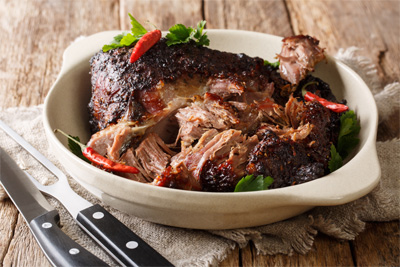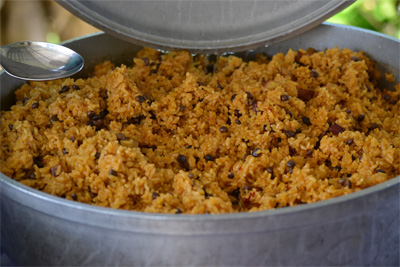Culture: Portrait of Our Soul
Cuisine
Cuisine
 I believe roast pork is the gateway to salvation. Anyone who disagrees is a fool and should be denounced. And never, ever trim the fat that adorns pork; it’s there for a reason. Fat liberates the soul and increases the flow of oxygen to the brain.
I believe roast pork is the gateway to salvation. Anyone who disagrees is a fool and should be denounced. And never, ever trim the fat that adorns pork; it’s there for a reason. Fat liberates the soul and increases the flow of oxygen to the brain.
All Caribbean children know this; our no-nonsense approach to the culinary arts is based on centuries of rigorous scientific analysis. Thankfully, our pioneering theories are now being championed at home and abroad.
When we were children, the United States was often described as a country where food was poorly seasoned and where people stumbled about in the kitchen without rhyme or reason. We also heard chilling tales of the “goat foot woman”– a mysterious being with furry goat feet instead of legs, who sometimes soared through the air without rhyme or reason.
At 43, I no longer fear the “goat foot” woman, but I still believe food should be prepared with ample seasoning and adequate reasoning. I have a legacy to uphold; I’m the grandson of well-known Crucian chef, Alma Doward. For decades, Grandma had a brisk business selling food during the Christmas carnival season, and folks would come from near and far to savor her treats
Like most Virgin Islanders, I grew up on dishes like kallaloo, fish and fungi, conch in butter sauce, crab and rice, saltfish and dumplings, red peas soup, bullfoot soup, souse and potato salad, stewed goat and seasoned rice, whelks, lechon pastels and roast pork, of course.
It is impossible, though, to talk about Virgin Islands cuisine outside of a larger Caribbean context. We West Indians eat many of the same dishes and some, like Kallalloo and fungi are of African origin. Kallaloo is a thick, spinach-like soup that almost always contains okra, fish, pieces of salted beef and pork and sometimes crab. And fungi is made of cornmeal and sometimes okra; it is commonly served with Kallalloo or fish.
 Kallaloo is prepared differently from island to island; you’ll even find variations on St. Croix. One “traditional” Crucian recipe calls for the leaves of local greens like “Papalolo,” “White Mary,” “Pusley,” “Bata-Bata,” “Bower” and “Tannia.” However, people often make Kallaloo by using only the leaves of Papalolo, and perhaps, store-bought spinach.
Kallaloo is prepared differently from island to island; you’ll even find variations on St. Croix. One “traditional” Crucian recipe calls for the leaves of local greens like “Papalolo,” “White Mary,” “Pusley,” “Bata-Bata,” “Bower” and “Tannia.” However, people often make Kallaloo by using only the leaves of Papalolo, and perhaps, store-bought spinach.
Because of our colonial past, you might also see remnants of Danish, French and Spanish influences in our foods. And like wise people are prone to do, we’ve also adopted dishes from neighboring islands and made them our own. My mother, for example, has become quite proficient at making pasteles – a Puerto Rican favorite especially around Christmas time. But even Puerto Rican pasteles, I’ve recently learned, is a legacy from our African forebears.
I’ve traveled the world, and I’ve sampled the cuisine of many cultures. Yet, I still crave the dishes of Africa and the Caribbean. The rich and varied cuisine of our ancestors soothes not only our bodies – it reminds us of who we are, where we’ve been, and where we yearn to go.